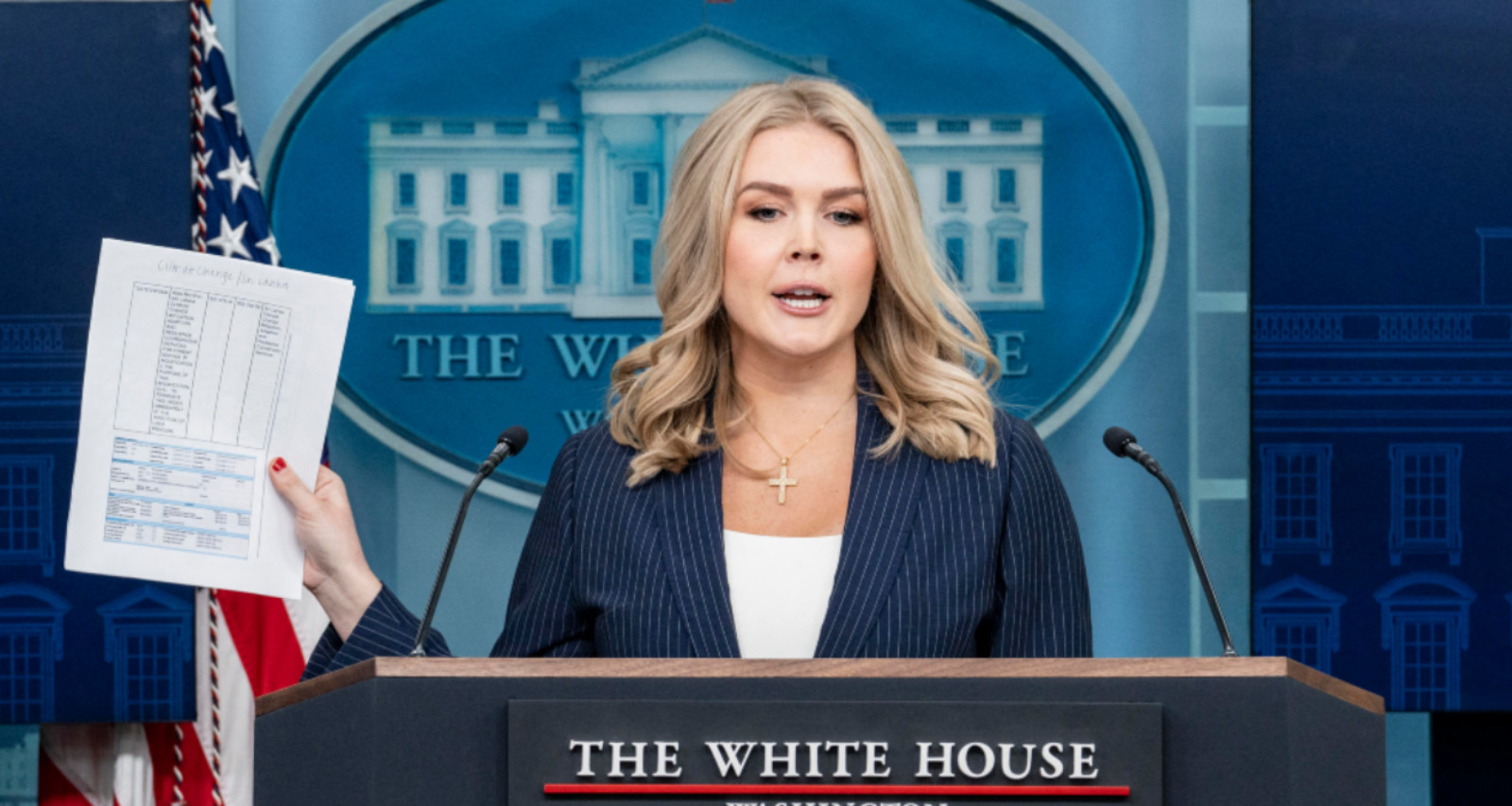NOTE:VIDEO AT THE END OF ARTICLE.
At a recent Axios media forum moderated by co-founder Mike Allen, White House Press Secretary Karoline Leavitt mounted a robust defense of the Trump administration’s sweeping overhaul of press-pool protocols and credentialing procedures. Casting the changes not as restrictions but as a means to broaden journalistic participation, Leavitt insisted that the reforms foster “more transparency, more accessibility, and greater access for a broad variety of outlets and a diversity of journalists.”
Critics—including the White House Correspondents’ Association (WHCA), legacy wire services, and press-freedom advocates—question whether these adjustments risk concentrating control over coverage and undermining the press’s watchdog role. This article examines:
-
The specifics of the administration’s modifications to the White House press-pool system and credentialing process
-
The rationale offered by the press secretary and her supporters
-
Responses from the WHCA, legacy media, and independent outlets
-
Historical precedents and comparative data on presidential media engagement
-
Broader implications for press freedom, democratic accountability, and global norms
1. The Administration’s Media-Access Reforms
1.1 From Permanent Seats to Rotating Spots
Traditionally, the White House press-pool system grants a fixed roster of approximately 13 reporters—often dominated by major wire services like the Associated Press (AP) and Agence France-Presse—a continuous presence at presidential events. The Trump administration has upended this model by instituting:
-
A Rotating Pool: Outlets now cycle through limited slots, ensuring that over a hundred credentialed outlets have the opportunity to cover the president directly on a rotating basis.
-
Digital-First Inclusion: Newer online publications, podcasts, and independent journalists are explicitly eligible for pool rotation, alongside traditional print and broadcast organizations.
Leavitt defended these steps as necessary to reflect the modern media ecosystem:
“We view them as opening access to more outlets, more voices, more journalists and outlets. Why should a single outlet have the privilege of being in that 13-person press pool every single day?”
1.2 Hard-Pass Credential Reductions
In May 2023, the administration announced revised criteria for “hard-pass” long-term credentials—passes that allow journalists daily White House access without special clearance. By August 2023, the number of active hard-pass holders had fallen by roughly 31%, as the White House removed inactive or seldom-covering reporters and tightened eligibility to those actively covering the beat.
Administration View: Streamlining the credentialed corps enhances security and ensures that only journalists who demonstrate consistent coverage requirements retain daily access.
Critics’ Concern: The cuts may restrict the range of voices on the beat and confer de facto influence on which organizations maintain constant proximity to presidential events.
2. Defending the Reforms: Leavitt’s Key Arguments
2.1 “More Transparency” Through Diversity
Leavitt argues that diversifying the pool yields a richer, more representative array of perspectives:
“There are thousands of outlets with White House press credentials. Hundreds show up every day. We’re simply giving more spots to more outlets and more voices.”
She further contends that the reforms honor President Trump’s own media approach—a nontraditional, digital-heavy campaign style that bypassed legacy outlets and directly engaged supporters via social platforms.
2.2 Challenging the WHCA’s Gatekeeping Role
The White House Correspondents’ Association has decried the changes as governmental overreach into press independence. Its statement—“the government should not be able to control the independent media that covers it”—underscores a core democratic principle. Leavitt counters that the WHCA itself wields gatekeeping authority:
“A small group of journalists on the WHCA board should not dictate who gets to go into the Oval Office or ride on Air Force One. There should be equal access for all outlets.”
2.3 Empirical Comparison to Biden Administration Practices
Leavitt and administration allies frequently point to President Biden’s markedly lower tally of press events during his first term—164 compared to 468 for Trump at equivalent points—as evidence of Trump’s superior accessibility. They argue that fewer formal press conferences under Biden signaled lower transparency, bolstering the case for Trump’s media reforms.
3. Legacy Media’s Pushback
3.1 Institutional Memory and Consistency
Veteran correspondents from the AP, Reuters, The Washington Post, and The New York Times emphasize that permanent pool membership fosters institutional memory and consistency. They note that legacy wire services:
-
Provide real-time, global distribution of official statements and events
-
Offer decades of historical context to interpret developments
-
Employ experienced photojournalists whose images (e.g., the “Fight, Fight, Fight” photo after the 2022 Pennsylvania assassination attempt) become indelible records
3.2 Concerns Over Coverage Gaps
Reporters worry that rotating slots may lead to intermittent coverage gaps, particularly for breaking news or unscheduled developments. Without a guaranteed permanent presence, smaller or less-resourced outlets may struggle to snap into the pool at short notice.
4. Independent and Digital Outlets: A Mixed Reception
4.1 New Voices, New Opportunities
Digital news platforms and independent bloggers generally welcome the chance to enter the formerly closed circle of White House coverage. They argue that:
-
Fresh Perspectives: Outsiders may ask different questions and cover under-reported issues.
-
Audience Reach: Many Americans—especially younger demographics—consume news online, not via wire services.
4.2 Skepticism About Implementation
However, some digital journalists caution that the system could be manipulated to favor ideologically aligned outlets. Without transparent, objective selection criteria for each rotation, there is potential for the administration to grant more frequent access to supportive organizations.
5. Historical and Global Context
5.1 Evolution of the Press Corps
-
Kennedy Era: Established televised press conferences and began formalizing pool protocols.
-
Reagan to Obama: Incremental expansions for TV crews, photojournalists, and online outlets, with the Obama team notably pioneering White House digital outreach.
-
Trump First Term: Clashes with individual reporters, occasional credential revocations, but largely intact institutional structures.
-
Biden Administration: High-profile COVID restrictions and fewer formal press conferences, though pool arrangements remained stable.
5.2 International Implications
U.S. press-access reforms carry symbolic weight globally. Freedom House and other watchdogs note that variations in American media openness may influence regimes elsewhere, some of which seek to justify press restrictions by pointing to U.S. practices.
6. Balancing Accessibility and Accountability
6.1 The Fundamental Tension
Democratic governance depends on both:
-
Government Transparency: Citizen access to unfiltered information about official actions.
-
Press Independence: Journalists’ freedom to question, investigate, and report without undue governmental influence.
Striking the proper balance requires policies that:
-
Prevent permanent monopolies over access
-
Maintain consistent coverage by capable outlets
-
Safeguard against manipulative credentialing that skews coverage
6.2 Toward Best Practices
Experts recommend:
-
Rotation with Oversight: Clear, published criteria and oversight by a neutral press-advisory committee to ensure fair pool selection.
-
Emergency Access Protocols: Guaranteed rapid inclusion of qualified outlets during breaking events.
-
Credential Review Transparency: Clear explanations for any credential revocations or pass reductions, with an appeals process.
-
Digital-Traditional Synergy: Hybrid approaches that leverage wire services’ distribution power alongside digital outlets’ niche expertise.
7. Conclusion
The Trump administration’s media-access reforms represent one of the largest structural changes to White House press operations in decades. By championing a broader, more digitally inclusive press corps, the administration asserts it is expanding transparency and accountability. Critics, however, remain wary that these changes could undercut the press’s watchdog function by fragmenting coverage and enabling selective access.
As the United States navigates an ever-evolving media environment—marked by digital fragmentation, social-media influence, and new technologies—the question remains how best to structure White House press access so that all Americans receive accurate, comprehensive, and timely information. The solution likely lies not in zero-sum battles between legacy and digital, government and press, but in collaborative frameworks that uphold press freedom while embracing modern journalistic innovation.
Only through such balanced, transparent protocols can the press and the presidency continue their essential, if often adversarial, partnership in a healthy democracy.

Adrian Hawthorne is a celebrated author and dedicated archivist who finds inspiration in the hidden stories of the past. Educated at Oxford, he now works at the National Archives, where preserving history fuels his evocative writing. Balancing archival precision with creative storytelling, Adrian founded the Hawthorne Institute of Literary Arts to mentor emerging writers and honor the timeless art of narrative.
